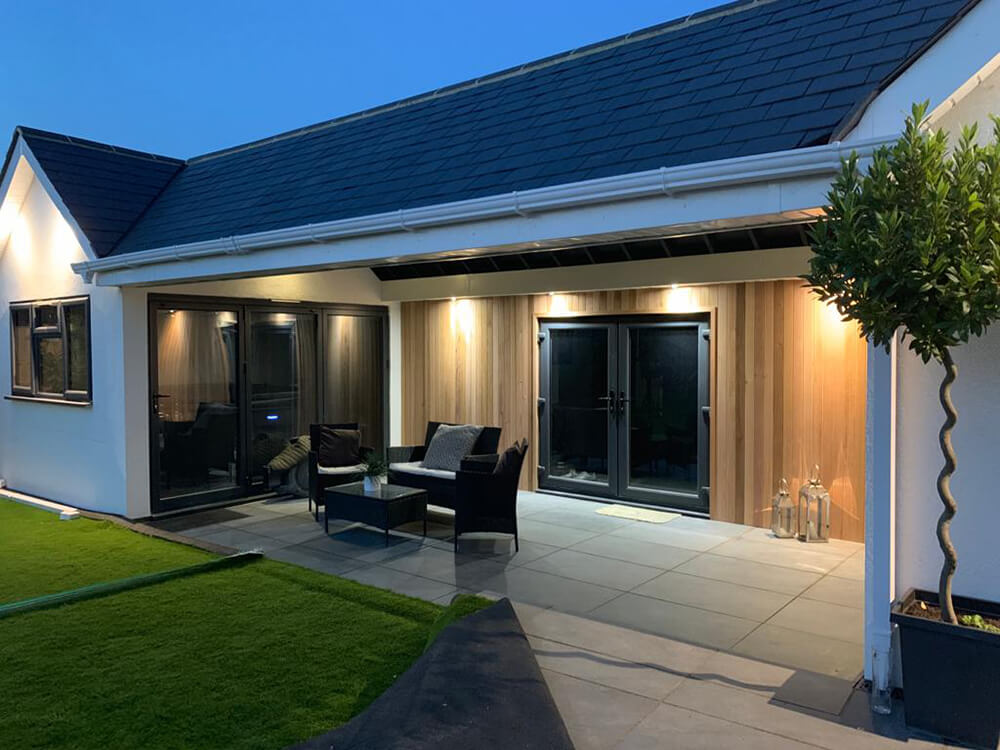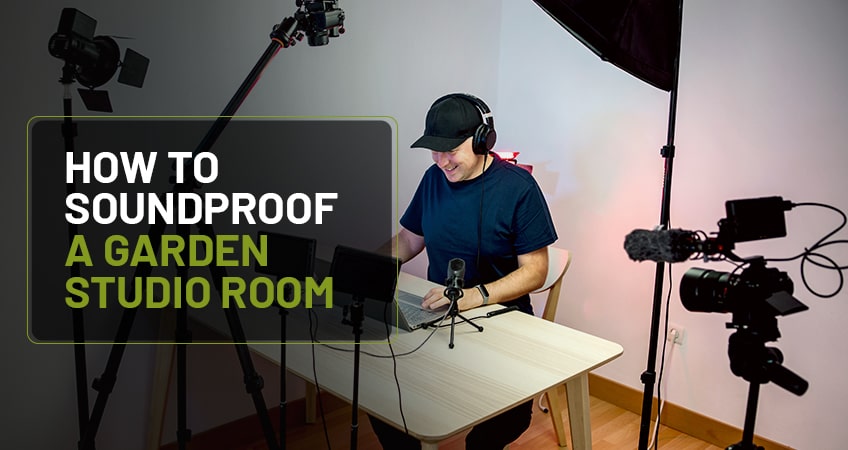Creating a garden studio is a dream come true for many music teachers, professional musicians & music producers. However, one critical aspect often overlooked is soundproofing. To ensure your garden studio serves as the perfect dedicated space for work, creativity, or music practice, effective soundproofing is a must.
This comprehensive guide will walk you through the importance of soundproofing, the basics of how sound travels, various soundproofing techniques, and a detailed step-by-step guide to DIY soundproofing. By the end, you’ll be well-equipped to transform your garden studio into a soundproof haven.
Why should you soundproof garden studios?

Soundproofing your garden room isn’t just about keeping noise out; it’s also about containing noise within your studio. For musicians, this means being able to practise without disturbing neighbours. For home studio owners and DIY enthusiasts, it means maintaining a peaceful working environment. Soundproofing enhances privacy, improves sound quality, and adds value to your property. Effective soundproofing is essential for a garden studio to significantly enhance its acoustic performance.
How sound travels and types of noise?
Understanding how sound travels is key to effectively soundproofing a music studio. Sound waves travel through air, solid materials, and even liquids, vibrating particles along the way. There are two main types of noise to consider:
- Airborne noise – This includes sounds like voices, music, and traffic. These sounds travel through the air and can easily penetrate windows, doors, and walls.
- Impact noise – This includes sounds like footsteps, vibrations from machinery, and other physical impacts. These sounds travel through solid structures, making floor and wall insulation crucial.
By knowing how sound travels, you can identify the best methods to block or absorb it.
Identifying noise sources and weak points

Before you start soundproofing, it’s essential to assess your space. Identify where noise is coming from and the weak points in your studio. Common sources of noise include windows, doors, and thin walls. Use these steps to assess your garden studio:
- Conduct a noise audit – Spend time in your studio at different times of the day. Make note of external noises and any disruptions.
- Check for gaps and cracks – Examine doors, windows, and walls for gaps or cracks where sound can easily penetrate.
- Identify flimsy structures – Thin walls, single-pane windows, and hollow doors are common weak points that need addressing.
Acoustic insulation panels and their placement
Acoustic panels are one of the most effective soundproofing tools available. They absorb sound waves, reducing echo and improving sound quality. Here’s how to use them:
- Choose the right panels – Acoustic panels come in various sizes and materials. Foam panels are great for high-frequency sounds, while fabric-wrapped panels handle a broader range of frequencies.
- Strategic placement – Place panels on walls and ceilings where sound waves are most likely to bounce. Corners and behind speakers are prime locations.
- Cover large surfaces – The more surface area you cover, the more effective the sound absorption. Consider adding panels to doors and windows as well.
Sealing gaps and cracks
Even small gaps can significantly affect your soundproofing efforts. Here’s how to seal them:
- Use acoustic sealant – Apply acoustic sealant around windows, doors, and any cracks in the walls. It remains flexible, allowing it to move with the structure without cracking.
- Install weatherstripping – Add weatherstripping around doors and windows to create an airtight seal.
- Fill larger gaps – Use expanding foam or acoustic caulk to fill larger gaps and holes in walls and ceilings.
Using mass-loaded vinyl
Mass-loaded vinyl (MLV) is a dense material that adds mass to walls, floors, and ceilings, effectively blocking sound. Here’s how to use it:
- Measure and cut – Measure the dimensions of your walls, floors, and ceilings. Cut the MLV to fit these areas.
- Install with adhesive – Apply adhesive to the back of the MLV and press it firmly into place. Ensure there are no gaps.
- Seal seams – Use acoustic tape to seal the seams between sheets of MLV, ensuring a continuous barrier.
Insulating with green glue and acoustic mineral wool
Green Glue is a soundproofing compound that converts sound energy into heat, dissipating noise. Here’s how to apply it:
- Prepare the surface – Clean and dry the surface where you’ll apply Green Glue.
- Apply the compound – Squeeze Green Glue onto the surface in a random pattern. A 0.5 cm bead is usually sufficient.
- Install the second layer – Press a second layer of drywall or plywood onto the Green Glue. Secure it with screws, ensuring even contact.
Building a double wall
A room soundproof garden studio provides excellent soundproofing by creating an air gap that blocks sound transmission. Here’s how to build one:
- Frame the second wall – Construct a second wall frame parallel to the existing wall, leaving a 5-10 cm gap between them.
- Install insulation – Fill the gap with soundproof insulation, such as mineral wool or fibreglass.
- Add drywall – Attach drywall to the new frame. Apply Green Glue between the layers for added soundproofing.
DIY vs. professional help
Deciding whether to tackle soundproofing yourself or hire a professional depends on several factors:
- Cost – DIY soundproofing can be more affordable, but it requires time and effort. Professionals may cost more but provide expertise and efficiency. Additionally, having a soundproof garden studio can save money on studio rental costs and travel expenses.
- Effectiveness – While DIY methods can be effective, professionals have access to advanced materials and techniques.
- Complexity – If your garden studio has unique challenges, such as irregular shapes or severe noise issues, professional help may be more beneficial.
Step-by-step guide to DIY soundproofing

Preparation
Tools Needed:
- Caulking gun
- Utility knife
- Measuring tape
- Screwdriver
- Staple gun
- Safety gear (gloves, goggles, mask)
Steps:
- Measure the Space – Identify areas to soundproof and measure dimensions.
- Gather Materials – Purchase necessary materials, including acoustic panels, MLV, Green Glue, and insulation.
- Clear the Area – Remove furniture and accessories from the studio.
Insulating the Walls
- Seal Gaps and Cracks – Use acoustic sealant and weatherstripping to ensure that garden music rooms maintain a comfortable temperature year-round while effectively blocking out various types of noise.
- Install Mass-Loaded Vinyl – Measure, cut, and attach MLV to the walls.
- Apply Green Glue – Spread Green Glue and add a second layer of drywall or plywood.
Insulating the Ceiling
- Install Acoustic Panels – Place panels strategically on the ceiling.
- Apply Mass-Loaded Vinyl – Attach MLV to the ceiling surface.
- Add a Second Layer – Secure additional drywall or plywood with Green Glue.
Insulating the Floor
- Lay Down Underlayment – Use soundproof underlayment before installing flooring.
- Apply Mass-Loaded Vinyl – Cut and lay MLV over the underlayment.
- Install flooring – Add your chosen flooring material on top.
Frequently asked questions
How much does a soundproof garden studio cost?
The cost varies based on materials and whether you DIY or hire professionals. Budget around £500-£2000 for a DIY project and more for professional services.
Can I soundproof a garden music room on a budget?
Yes! Focus on high-impact areas like doors and windows first. Use affordable materials like acoustic sealant and weatherstripping.
How long does it take to soundproof a garden music studio?
A DIY project can take a few days to a week, depending on the complexity. Professionals can complete the job faster, often within a few days.
Invest in your garden music room’s future
Soundproofing your garden studio to create a soundproof music room is an investment in your creativity, productivity, and peace of mind. Whether you’re a musician seeking the perfect practice space, a home studio owner needing a quiet workspace, or a DIY enthusiast looking to enhance your craft, effective soundproofing is essential.
For those who prefer a professional touch, Garden Rooms 365 offers bespoke garden rooms fully soundproofed by experts. Get in touch with us today and elevate your garden studio experience!



